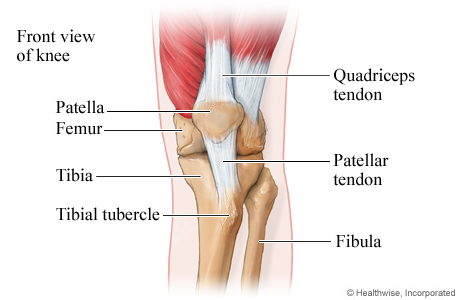On this page
What Is Osgood-Schlatter Disease?
Knee pain is a common complaint among growing young athletes.
Doctors define Osgood-Schlatter as an inflammatory disease of the growth plate at the top of the shin. This growth plate is a soft tissue called cartilage.
It gets inflamed by repeated motion as the knee's main tendon pulls on the shin.
When a child finishes growing, their cartilage hardens into bone. Until then, these parts of the body can become inflamed when overused.
Active children are more at risk of overuse injuries in their joints, like the knee. Osgood-Schlatter affects about 10% of adolescents.
What causes Osgood-Schlatter disease?
Tendons attach muscles to bones. These fibrous bands help our joints move.
The patellar tendon is a tendon in your knee that holds your kneecap in place.
It starts at the thigh muscle and attaches to the front of the shinbone, right below the knee. When overused, it can cause Osgood-Schlatter disease.
The constant pulling of that knee's tendon on the shin's growth plate causes pain and swelling.
It happens with young people because their bones and muscles don't all grow at the same rate. Their growth plates are also cartilage that hasn't hardened into bone yet. That means the plates are more at risk for injury.
Osgood-Schlatter usually goes away once a child stops growing. Their bones, muscles, and tendons become more "in balance," and the growth plates have sealed into bone.
What are the risk factors and complications of Osgood-Schlatter disease?
Young athletes are most at risk for Osgood-Schlatter disease. It's most common in those who play sports that involve jumping, running, and landing.
Sports that seem to have the highest rate of this knee condition include:
- Soccer.
- Gymnastics.
- Basketball.
- Cross-country, track, and distance running.
Children who aren't athletes can also get Osgood-Schlatter.
Doctors diagnose Osgood-Schlatter most often in girls between 8 and 12 and boys between 12 and 15.
It lasts between 12 to 24 months and resolves on its own 90% of the time.
There are no long-term complications in most cases.
Sometimes a person with Osgood-Schlatter has a bump below the knee. The bump is usually painless. If it does cause pain, doctors may suggest surgery to remove it.
Back to top
What Are the Symptoms of Osgood-Schlatter disease?
Symptoms of Osgood-Schlatter disease often include knee problems, such as:
- Pain below the knee.
- Tenderness.
- Swelling.
Sometimes the tendon in your knee may pull a tiny piece of the bone or cartilage away from the shin, causing pain. The pain can make sports and daily activities hard.
While there isn't a "cure," there are things that sports medicine doctors can do to help manage symptoms.
If knee pain is getting in the way of your child's normal routine, you might want to see a sports medicine specialist.
Back to top
How Do You Diagnose Osgood-Schlatter Disease?
Doctors at UPMC Sports Medicine can diagnose this knee problem by asking about your symptoms and doing a physical exam. They'll also ask about what sports you play and when the pain seems to be the worst.
The doctor will press on the area below the knee. If the site is tender and painful, this is a good sign of Osgood-Schlatter.
They may do an x-ray to rule out other knee injuries or problems.
Back to top
How Do You Treat Osgood-Schlatter disease?
The main treatment goals for Osgood-Schlatter disease is to:
- Control your knee pain.
- Limit any activities that could make it worse.
Osgood-Schlatter disease treatments can include:
- R.I.C.E. (rest, ice, compression, elevation).
- Anti-inflammatory drugs, such as ibuprofen, to reduce pain and swelling.
- An elastic wrap or a neoprene sleeve around the knee to secure the joint.
- Stretching, flexibility, and physical therapy exercises for the thigh and leg muscles.
Osgood-Schlatter disease rarely requires surgery to treat symptoms.
How can I prevent Osgood-Schlatter disease?
You might not be able to prevent Osgood-Schlatter disease, but you may be able to lower your risk of getting it.
A few tips on how to lower your risk of Osgood-Schlatter disease include:
- Adjusting your activities.
- Stretching your leg muscles.
- Doing routine lower body strengthening exercises.
Back to top

















